By Nereida (Neddy) Perez
Employee Resource Groups (ERGs), often referred to as Business Resource Groups (BRGs), are an amazing part of many companies’ diversity and inclusion strategies. These groups help provide a safe space for people to learn about one another or connect with likeminded people across business lines or in the local communities in which employers are located. They also serve as resources for companies to discover new talent and/or assess the skills of high potentials.
For many companies wanting to find creative or innovative solutions to business challenges, BRGs provide opportunities to gain unique perspectives by using them as focus groups or by leveraging them to drive business results. For example, in the case of one financial services company that struggled with bringing in Hispanic-owned businesses, the BRG came up with a plan to visit Hispanic owned businesses with an account manager from the company. Within a matter of three months the company landed five new clients each worth more than $7 million dollars and one worth $100 million. In three months, the company saw an increase in revenue from a niche with which, previously, they were unsure of how to connect.
Here are a few ideas to help focus the energy of your BRGs as an executive sponsor/champion and/or diversity and inclusion practitioner:
- Share your company’s talent or business strategy with BRG leadership. Explain the top five priorities in each area and ask the BRG leadership team to select one or two areas it can support and make part of its goals.
- Introduce the concepts of goal setting, and metrics or scorecards to team members. Because they provide an opportunity to reach a new employee segment for leadership development, participants are committed to learning new skills. In addition, once you get them grounded in using the company’s tools they will be able to apply these concepts not only to their BRG projects but they will also be able to use their new skills in their full-time roles.
- Coach and train team members on how to quantify the dollars requested for funding versus the potential impact of the event or program, as they develop their goals for the year.
- Leverage the BRG to focus on a related company issue. An electric utility in the Northeast was trying to figure out why there were no home energy audits taking place in the Asian community. Management asked the Asian BRG to come up with suggestions. The group developed a recommendation generating 4,000 home energy audit leads. So, ask, “What can your BRG do for you?”.
- Be creative. BRGs are often encouraged to support company efforts in four main areas: talent acquisition, community engagement or volunteerism, and/or supporting diversity awareness and training. However, they are also very apt at helping companies with:
Onboarding; serving as a focus group on a new product launch; working on business cases; testing out new leadership development materials; translations, and; providing input on company policy changes; etc.
In order to assess results, it is not enough to look at how many ideas are generated. Rather, BRGs need to leverage business tools to track impact. A few ways in which to measure impact include:
- Community Relations and Brand – Consider tracking total participation against cost of an event or track the number of media impressions or the number of people impacted in the community as a result of the BRG’s involvement (e.g. quantify how many people received a meal or participated in mentoring, etc.)
- Talent Acquisition – If you have an employee referral program in place, track the number of candidates who were referred by employees. Other ways to track impact include reporting on how many recruiting events the BRG participated in and the number of resumes or candidates that each event yielded.
- Business Impact – If the BRG is focused on increasing supplier diversity, report out the percentage or dollars saved from all new vendors contracted as a result of the team’s efforts. If the BRGs are asked to provide input on a new product launch and their input is adopted, report on the revenue generated or the overall savings as a result of their efforts.
- Business Transformation – Companies often conduct culture or employee engagement surveys, however they do not always survey the impact of a business transformation project. If the BRG is engaged in a transformation project, it’s important to conduct a survey after implementation to measure and understand overall impact. Some transformation metrics include: productivity, customer satisfaction, revenue generated and quality of production.
Business management and tracking tools are often at the disposal of BRGs but members may not know how to use them or know how to gain access, which often makes measuring impact spotty. One way to turn this around is to leverage the Diversity & Inclusion Office or BRG program manager to provide coaching and guidance. The Diversity & Inclusion Office or program manager can connect BRG leadership to groups like Training and Development, Operations Excellence and/or key leaders to help provide training, coaching . ERGs/BRGs can be a tremendous business resource. With a little direction and nurturing they can have a significant impact on a company’s strategic efforts and its bottom line by supporting the brand image, improving retention and increasing employee productivity.
Nereida (Neddy) Perez is a global leader in the diversity & inclusion space best known for creating innovative strategies designed to increase business results by helping companies better leverage the talent of their employees. You can reach her at: https://www.linkedin.com/in/neddyperez/









